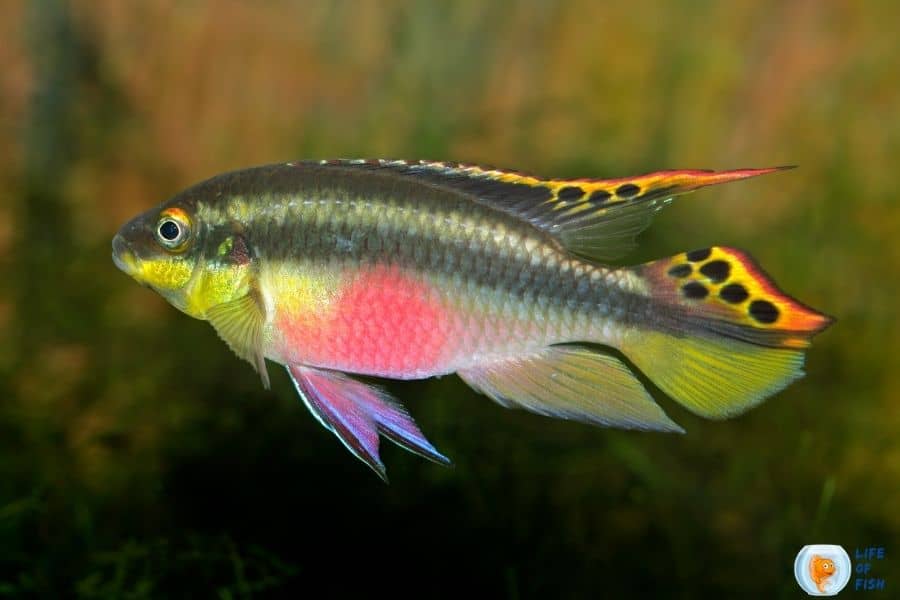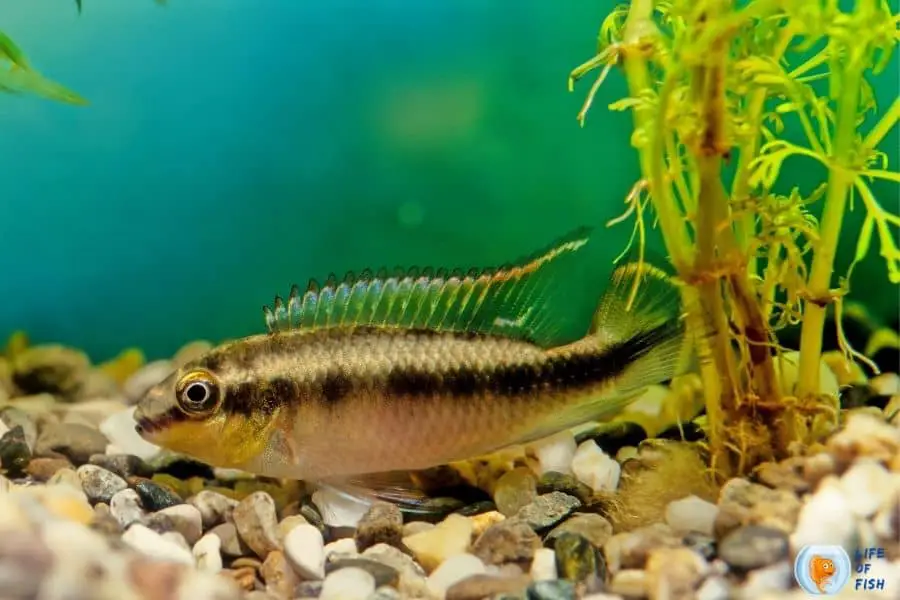Kribensis Cichlid, krib rainbow cichlid, rainbow krib, purple cichlid, or Pelvicachromis pulcher is highly popular among hobbyists due to their incredible colors and cute size. On the other hand, there are some interesting factors about Kribensis Cichlid size. Dive deep to know them!

Kribensis Cichlid Max Size
Jump To
- 1 Kribensis Cichlid Max Size
- 2 Kribensis Cichlid Size In Captivity
- 3 Kribensis Cichlid Appearance
- 4 Kribensis Cichlid Lifespan
- 5 What Do They Eat?
- 6 Is kribensis cichlid aggressive?
- 7 Can a kribensis bite you?
- 8 Kribensis cichlid tank mates
- 9 Kribensis Cichlid breeding
- 10 Recently Asked Questions
- 11 Conclusion
When you research the average size of kribensis cichlid, you can find out that kribensis cichlids are 4 inches in length. So they are considered dwarf cichlid. But generally, there is a gender difference among almost all the creatures on the earth. So, when it is better to consider the size of female and male fish separately.
When it comes to male kribensis cichlid fish’s size, it is the same as their overall average size, 4 inches or 10cm. But the female Kribensis cichlid is 3 inches or 8 cm in length. Here you can clarify that the Kribensis cichlid is not large like their other cousins. Kribensis cichlid is small and not large at all.
Kribensis Cichlid Size In Captivity
According to the records, kribensis cichlid can reach up to 4 inches in general. But nature has more secrets. So, exceptionally, there may be kribensis cichlids that are larger than their average size in the wild. However, your kribensis cichlid can reach their average maximum size in captivity too. It means males can grow up to 4 inches while female fish grow up to 3 inches. But here, you have a responsibility to care for them well. It means that you have to feed them well while keeping them in a preferable and stress-free environment.
Kribensis Cichlid Appearance
Shape and fins
Kribensis cichlid also comes up with familiarity with the appearance of cichlids. Kribensis cichlid has a tall and slim body with a rounded head. When deeply considering their fins, the most noticeable thing is fins are pointed and long. Their dorsal fin is curved to a dramatic point and ends with the back of the body. Also, both female and male kribensis cichlid’s dorsal fins and tail fins are edged in red and yellow colors. Another notable factor associated with the appearance of kribensis cichlid is almost all kribensis cichlids have black dots.
If you carefully search, you can find these black dots on the top of the fan-shaped tail fin and the tops of the dorsal fin. However, these dots look like eyes. Also, long pelvic fins are a common sign of this fish species. However, the color combination of these fins also gives a pretty and rainbow look to kribensis cichlids. Check out their pelvic fins. Many fish’s pelvic fins color with beautiful bright colors and decorate with streaks of metallic blue.
Color pattern
However, the most eye-catching thing is their coloration. Their base coloration is ranging grey to white. Further, the kribensis cichlid’s body has a striking black stripe running from the eye to the tail. This enhances the unique look of kribensis cichlid’s base color. Not only that, the black color on the top of their head adds a stunning look to kribensis cichlid. Then it comes to the female kribensis cichlid, which has an attractive reddish-pink belly. This appearance can be seen on the belly of some female fish as pink dots.
It is more attractively and vibrantly displayed during their breeding season. However, the male kribensis cichlid does not come with a pink hue. But males have a most beautiful appearance that almost all hobbyists always love. That is its fins. Males kribensis cichlid come with beautiful fins which have the ability to catch anyone’s eyes.
However, there are many color varieties of kribensis cichlids. Usually, many hobbyists complain that the kribensis cichlids in stores do not have a bright look. In this case, do not worry. The only thing that you should do is keep this type of fish in a well-maintained environment. If your fish do not have any disease, this method surely helps to get their colorful appearance. However, here I try to tell you a critical factor: a bright and vibrant appearance is a good indicator of the overall health of fish. So, always try to maintain the eye-catching look of your fish.

Kribensis Cichlid Lifespan
Comparatively, kribensis cichlid is short-lived cichlid species. That is because generally, kribensis cichlid is difficult to live for more than 5 years in captivity. But there are some exceptional cases where some kribensis cichlid lived longer. However, 5 years is the usual lifespan of kribensis cichlid. Also, you only can keep this fish for five years under pristine conditions and with great care.
Like other fish species in the aquarium industry, kribensis cichlid is highly sensitive to poor water conditions. Similarly, kribensis cichlid will respond poorly to dramatic water changes and also suboptimal habitats. So, if you want to keep them healthy and support them to maximize their lifespan, it is very important to keep them with the best care.
What Do They Eat?
Kribensis cichlids are omnivores. So, they are ready to eat both plant and animal matter. However, sinking cichlid pallets play a prominent role in their diet. Because usually, these fish species like to live enough time at the bottom of the tank. In addition to that, you can feed them foods that contain high proteins. So, it is better to add live and frozen foods to their diet.
According to my experience, they enjoy their diet if you add baby brine shrimp, bloodworms, daphnia, or larvae to their diet. They also appreciate prepared food like frozen brine shrimp. So, you can satisfy Kribensis cichlids’ vegetable intake by adding small chunks of zucchini and peas into their diet.
Is kribensis cichlid aggressive?
Actually, the behavior of the Kribensis cichlid is complicated, and it highly depends on the situation. However, the most suitable answer for this question is that Kribensis cichlids are not aggressive; they are peaceful but in the right or preferable environment. However, if you provide preferable conditions, you can keep them in also the community tanks. Anyhow, the most terrible thing that is associated with their behavior is territorial guardians.
This behavior can be highly noticeable in their breeding season. However, if Kribensis cichlids have enough space and hiding spots like caves, this issue is not a big deal. Another issue is that Kribensis cichlids tend to nip the fins of other fish in your tank, especially slow-moving fish. In addition to that, this fish species may tend to dig the sand substrate and uproot your live plants. Some people misunderstand this behavior as a sign of their aggression. But it is not. Typically, Kribensis cichlids are very active freshwater fish species.
Can a kribensis bite you?
Generally, they do not bite humans. But there were rare cases where Kribensis cichlids were eating their slow-moving tankmates. But this is not their usual behavior. Even though they nip other fish’s fins, kribs do not bite others. These rare cases happen when the tank is overcrowded or too small.

Kribensis cichlid tank mates
Kribensis Cichlids are non-aggressive, and peaceful but they are very territorial. However, if you keep them in a preferable environment with enough space, you can keep them in the community tank with other tank mates. Simply, it can be concluded that the Kribensis cichlids are peaceful and protect their territory. However, another bad habit of Kribensis cichlids is, that they nip the fins of their tank mates. So, the answer is up to you. My recommendation is you can keep Kribensis cichlids with suitable and selected tank mates. So, here I mention a few Kribensis cichlid tank mates.
- Cory Catfish
- Apistogramma
- Siamese Algae Eater
- Congo Tetra
- Most types of plecos
- Tiger Barb
- Harlequin Rasbora
Kribensis Cichlid breeding
They need a special setup for their breeding purposes such as a separate breeding tank, Laval raring tanks for baby fish and specific water quality. You can find out how to breed them in our article kribensis cichlid breeding.
Recently Asked Questions
Is Kribensis A Cichlid?
Yes. Kribensis Cichlids are a colorful member of the cichlid family. However, most of the members of the cichlid family are pretty large and somewhat aggressive. But Kribensis cichlids are different from their large cousins. Thus, they are comparatively small in size and non-aggressive. But do not misunderstand; they belong to the cichlid family.
What Is The Giant Alligator Gar?
Simply alligator is the biggest member of the gar family. Also, you can call alligator gar Atractosteus spatula. Not only that, according to the records, the alligator gar is the biggest freshwater fish species in North America. The fantastic thing is, alligator gar can grow about 10 ft or 3.0 m in length. So, now you can imagine how big this guy is.
Generally, alligator gar has torpedo-shaped bodies, and usually, they are brown or olive in color. The most special factor in the appearance of alligator gar is their scales. Thus, their scales are not like other fish species’ scales. These scales are ganoid scales and are bone-like. Also, they have rhomboidal-shaped scales with serrated edges. Further, this predatory fish has a dual row of large, sharp teeth that help to hold prey.
Conclusion
Kribensis Cichlid, krib rainbow cichlid, rainbow krib, or Pelvicachromis pulcher is a popular fish species that belong to the cichlid family. But they differ in their large relations. However, the most leading factors that highlight their difference are their size and non-aggressiveness towards other fish species. Simply, kribensis cichlid is the most colorful and vibrant small fish in your freshwater aquarium. kribensis cichlid is the most fun to watch. I am sure if you add this gorgeous fish to your collection, you will spend a surprising amount of your time observing them.
Read Next : How Often to Feed Cichlids? Cichlid Feeding Guide | Everything To Know |
